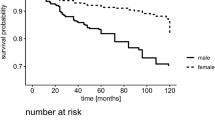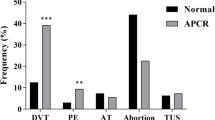Abstract
The aim of this study was to investigate a relationship between FVL-mutation and levels of haemoglobin (Hb) in patients with venous thromboembolism (VTE). From March 1998 to December 2005, 927 consecutive patients with objectively diagnosed VTE were registered in the Malmö Thrombophilia Study (MATS). Female patients with FVL-mutation below 50 years of age had significantly higher median-Hb (133 vs. 126 g/l; P < 0.001) compared to female patients below the age of 50 years without FVL. No significant difference could be found for men or women above 50 years of age or men below 50 years of age. Female patients below the age of 50 years with FVL-mutation and VTE are associated with higher median Hb, and this finding is in accordance with earlier hypothesis that FVL-mutation may have constituted an evolutionary selection advantage.
Similar content being viewed by others
References
Zivelin A, Griffin JH, Xu X, Pabinger I, Samama M, Conard J, Brenner B, Eldor A, Seligsohn U (1997) A single genetic origin for a common Caucasian risk factor for venous thrombosis. Blood 89(2):397–402
Dobbie BM (1982) An attempt to estimate the true rate of maternal mortality, sixteenth to eighteenth centuries. Med Hist 26(1):79–90
Bertina RM, Koeleman BP, Koster T, Rosendaal FR, Dirven RJ, de Ronde H, van der Velden PA, Reitsma PH (1994) Mutation in blood coagulation factor V associated with resistance to activated protein C. Nature 369(6475):64–67. doi:10.1038/369064a0
Rees DC, Cox M, Clegg JB (1995) World distribution of factor V Leiden. Lancet 346(8983):1133–1134. doi:10.1016/S0140-6736(95)91803-5
Dahlbäck B, Carlsson M, Svensson PJ (1993) Familial thrombophilia due to a previously unrecognized mechanism characterized by poor anticoagulant response to activated protein C: prediction of a cofactor to activated protein C. Proc Natl Acad Sci USA 90(3):1004–1008; comment in: Thromb Haemost 72(6):987–988 (1994). doi:10.1073/pnas.90.3.1004
Svensson PJ, Dahlbäck B (1994) Resistance to activated protein C as a basis for venous thrombosis. N Engl J Med 330:517–522. doi:10.1056/NEJM199402243300801
Rosendaal FR (2005) Venous thrombosis: the role of genes, environment, and behavior. Hematology (Am Soc Hematol Educ Program): 1–12. doi:10.1182/asheducation-2005.1.1
Dahlbäck B (1999) Activated protein C resistance and thrombosis: molecular mechanisms of hypercoagulable state due to FVR506Q mutation. Semin Thromb Hemost 25(3):273–289
Lindqvist PG, Svensson PJ, Dahlback B, Marsál K (1998) Factor V Q506 mutation (activated protein C resistance) associated with reduced intrapartum blood loss—a possible evolutionary selection mechanism. Thromb Haemost 79(1):69–73
Lindqvist PG, Svensson PJ, Marsaal K, Grennert L, Luterkort M, Dahlbäck B (1999) Activated protein C resistance (FV:Q506) and pregnancy. Thromb Haemost 81(4):532–537
Lindqvist PG, Zoller B, Dahlback B (2001) Improved hemoglobin status and reduced menstrual blood loss among female carriers of factor V Leiden—an evolutionary advantage? Thromb Haemost 86(4):1122–1123
Donahue BS, Gailani D, Higgins MS, Drinkwater DC, George AL Jr (2003) Factor V Leiden protects against blood loss and transfusion after cardiac surgery. Circulation 107(7):1003–1008. doi:10.1161/01.CIR.0000051864.28048.01
Zöller B, Svensson PJ, He X, Dahlbäck B (1994) Identification of the same factor V gene mutation in 47 out of 50 thrombosis-prone families with inherited resistance to activated protein C. J Clin Invest 94(6):2521–2524. doi:10.1172/JCI117623
R Development Core Team (2005) R: a language and environment for statistical computing. R Foundation for Statistical Computing, Vienna. ISBN 3-900051-07-0. http://www.R-project.org
Kerlin BA, Yan SB, Isermann BH, Brandt JT, Sood R, Basson BR, Joyce DE, Weiler H, Dhainaut JF (2003) Survival advantage associated with heterozygous factor V Leiden mutation in patients with severe sepsis and in mouse endotoxemia. Blood 102(9):3085–3092. doi:10.1182/blood-2003-06-1789
Weiler H, Kerlin B, Lytle MC (2004) Factor V Leiden polymorphism modifies sepsis outcome: evidence from animal studies. Crit Care Med 32(5 Suppl):S233–S238. doi:10.1097/01.CCM.0000126126.79861.08
Yan SB, Nelson DR (2004) Effect of factor V Leiden polymorphism in severe sepsis and on treatment with recombinant human activated protein C. Crit Care Med 32(5 Suppl):239–246. doi:10.1097/01.CCM.0000126122.34119.D1
Acknowledgements
We are most grateful to Andreas Hillarp for reading our project and sharing his scientific expertise (experience). We also thank Camilla Nilsson for skilful technical assistance. The MATS study is in part supported by Anna o Edwin Bergers’ foundation, Stockholm.
Author information
Authors and Affiliations
Corresponding author
Rights and permissions
About this article
Cite this article
Isma, N., Breslin, T., Lindblad, B. et al. The Factor V Leiden mutation is associated with a higher blood haemoglobin concentration in women below 50 of the Malmö Thrombophilia Study (MATS). J Thromb Thrombolysis 28, 255–258 (2009). https://doi.org/10.1007/s11239-008-0293-z
Received:
Accepted:
Published:
Issue Date:
DOI: https://doi.org/10.1007/s11239-008-0293-z




